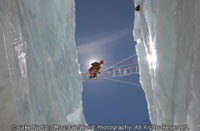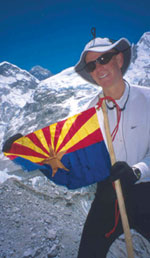|
 |
| Climber/photographer Jake Norton '96
took this picture of Ngawang Sherpa using a ladder to
cross a massive crevasse in the Khumbu Icefall at 18,000
feet on Mount Everest, Nepal. |
Norton, who first went to Nepal while still in high school,
returned there during his sophomore year at CC, then again
during his senior offer generous hospitality toward visitors,
even though the average annual income is around $200. Also,
Norton says,
there's almost an intellectual curiosity about foreigners.
"It's not uncommon at all to have a total stranger
invite you to their home for tea," says Norton.
Summit Satisfaction
Since graduation, Norton has worked as a guide and a photographer.
He's climbed Washington's Mount Rainier a few times. (Okay,
several dozen times.) And he's been back to South Asia 13
times, including four expeditions to Mount Everest.
On one of those trips in 1999, Norton and his team made
international news and stirred up controversy by discovering
and photographing the body of George Mallory, the pioneering
British climber stranded on the mountain in 1924.
 |
| Brian O'Connor '82 at base camp, preparing
to summit Mount Everest, the last
challenge in his goal to climb the highest peak on each
continent: "To me,the best part of climbing was always where I was, not
necessarily what I was doing," says O'Connor. |
Norton finally reached the summit of Everest in 2002 while
on assignment for the Discovery Channel, but found the top
of the world strangely anti-climactic. "I got to the
summit and kind of expected all these high-fives and trumpets
blaring in my ear. But you get up there, take a few pictures,
turn around, and go home." The experience as a whole
is what counts, he says. "It's the size of the mountain
and not the top." O'Connor's Everest summit was the
culmination of a goal he set in 1986 to climb the highest
peak on all seven continents, including Antarctica. But
Mother Nature didn't cooperate for the final leg of his
journey, inflicting 80-mile-per-hour winds and a wind chill
far colder than 100 degrees below zero, which made the oxygen
tanks inoperable. "Horrendous," says O'Connor.
"It was an extremely high-wind year!"
Because It's There
For all its high points, mountain climbing is filled with
danger, physical hardship, and, as Katy Garton found out
while hiking the Juneau ice fields, endless hours in wet
clothing that just won't dry. So what keeps climbers
coming back to the biggest hills on earth?
"It's an inward journey. It's just you. You're the
one that's climbing. You can't blame anything that happens
on anyone else," says Conlin. Norton concurs, adding,
"It's a game where you're in this constant battle between
what your body is telling you and what your mind is telling
you. It's a combination of the physical and mental challenge
and the physical and mental growth you go through, every
time you go to the mountains."
1
| 2 | 3
|